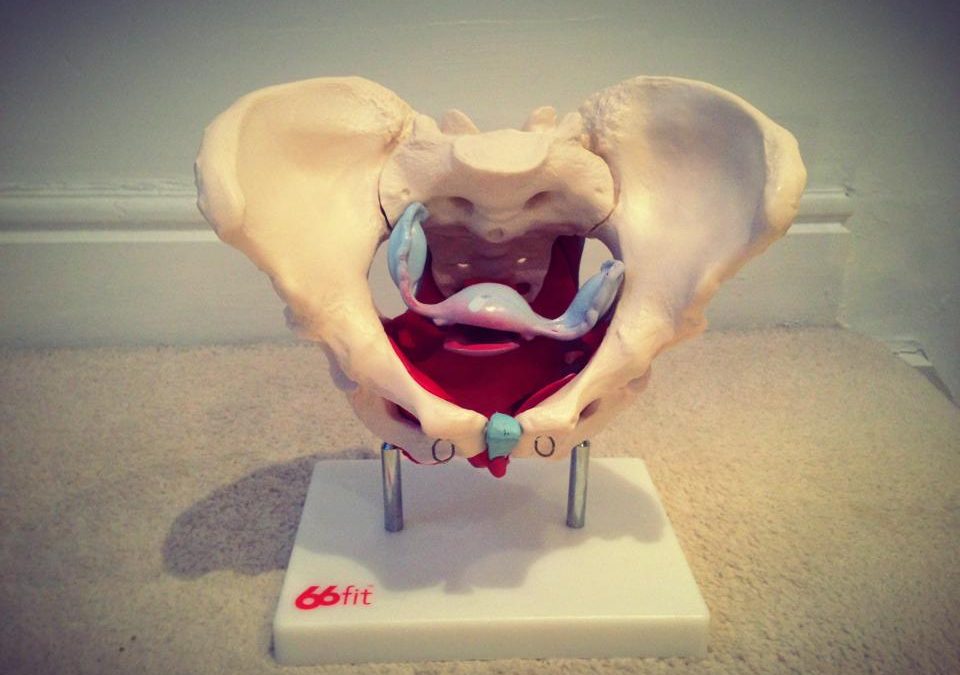Pelvic Floor Health starts here!
The blue bit in the middle is the Uterus, Ovaries and Fallopian Tubes.
The blue bit on the front of the pelvis is a ligament – this ligament loosens during pregnancy to allow for the growth and birth of the baby.
The red bits at the muscles of the pelvic floor (there are more than this and its not an exact scale).
You can see they kind of act as a sling across the bottom of the pelvis (that’s quite a simplistic description). They attach to your Ischium (aka Sit Bones), your Sacrum and Coccyx (very bottom of spine, fused vertebrae) and the Pubic Bone (bones at front, where that blue ligament is).
It is not just one muscle, its is a few layers of muscles with different attachment sites.
This is a simplistic version, there are lots of other ligaments, tendons and fascial attachments around here as well. These attachments to other muscles that move our body and legs are really important – to me as a Movement teacher and therapist. Knowing about these help me figure out why you have persistent aches and pains. That’s why we sometimes ask you unusual – seemingly irrelevant questions.
The purpose of our pelvic floor is:
– to hold the organs in our pelvis and abdomen, and of course babies if you’re a woman.
– work with our diaphragm, abdominal muscles and back muscles to provide strength for our spine when we move around – especially heavy lifting
– stop us peeing and pooping at inappropriate times!
Your pelvic floor is designed to lengthen and shorten like any muscle. When it lengthens it might still be contracting, when it shortens it might not be contracting! (all muscles are capable of this).
For example:
Imagine you’re going to sit down on a chair.
– You bend forward at the hips, stick your bum out (if you’ve been in my class lately you know exactly what I mean!)
– the Fascia (connective tissue) on your sit bones/Ischium lengthen slightly (this is a tiny move you won’t feel)
– your pelvic floor muscles lengthen (it contracts and lengthens – this is what prevents your fascia separating too far!)
– you lower your bum to the chair, then sit upright
– the fascia comes back to its normal position, your pelvic floor goes back to its resting length
When you stand back up again
– you lean forward and the fascia lengthens slightly
– your pelvic floor muscles lengthen – whilst contracting
– your push with your feet and use your leg and hip muscles (glutes) to stand you up
– when you are stood upright the fascia returns to it’s original length and your pelvic floor muscles return to their resting length.
Problems can occur because:
– You sit all day so your pelvic floor muscles become short and weak
– You’ve been pregnant and the weight of the baby has pressed down on the muscles, expecting more of them
– You’ve delivered your baby via your pelvic floor and they’re in shock!
– You don’t stand up properly, your hip bones don’t sit in their position in the hip joint, so your pelvis stays sticking out, or too tucked in
– Your going through menopause. Your hormones are changing and your bladder can shift slightly, causing it to demand more help from your pelvic floor muscles to hold its weight.
– You’re a runner, are or have been a trampolinist or gymnast, or have done aerobics, or similar, for years. Repetitive impact means more demands on the pelvic floor muscles. These are not BAD activities, but it is more important to do core stability/mobility/strength exercises.
If you have Pelvic Floor problems you probably experience some of these:
– urge incontinence (when you have to dance to the toilet)
– general incontinence (you have to wear full on Tena lady or more)
– stress incontinence (when you pee when you run, laugh or cough)
– worry that you might pee in an inappropriate place/time
– back pain
– painful sex
– repetitive water infections
This is just the start! There are many other ways our pelvic floor doesn’t work like we want it to. Sometimes repetitive back pain can cause problems with other associated muscles.
Please don’t be embarrassed any more! You’re not alone and we can help.

